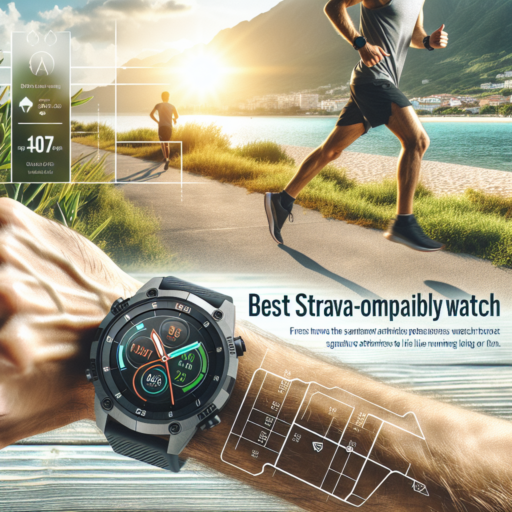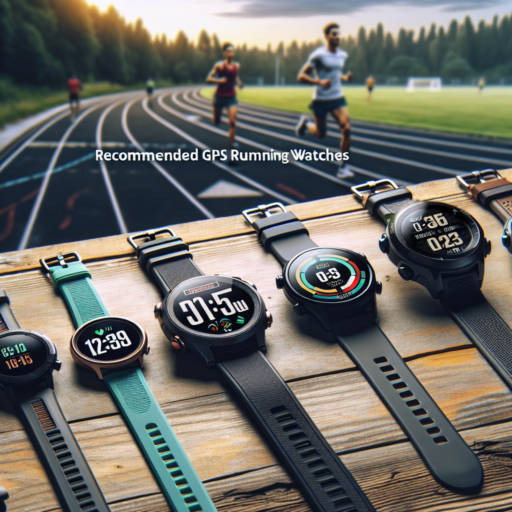Introduction to the Best Fitness Trackers for Strava Users
Strava, a beacon for fitness enthusiasts worldwide, provides an intricate map of workouts and competitive analyses that cater to both amateur and professional athletes. The platform’s compatibility with various fitness trackers elevates the user experience, making the choice of an ideal device imperative for maximizing performance analytics. This introduction delves into the best fitness trackers tailored for Strava users, guiding you towards making an informed choice that aligns with your athletic goals and lifestyle preferences.
Understanding the symbiosis between fitness trackers and Strava is crucial for those aiming to enhance their workout routines. These devices not only monitor physical activity but also sync seamlessly with Strava, providing detailed insights into your performance metrics such as pace, distance, heart rate, and much more. With several options available in the market, ranging from simplistic bands to feature-rich smartwatches, the decision often boils down to personal preference and specific fitness goals.
Key features to consider when selecting a fitness tracker for Strava users include GPS accuracy, heart rate monitoring, battery life, and waterproof rating. Additionally, the device’s compatibility with Strava’s extensive feature set—like segment leaderboard participation, route navigation, and live feedback—plays a significant role in enriching the training experience. In the next paragraphs, we will explore some of the top-rated fitness trackers that stand out in these categories, helping you push your limits while staying connected with the Strava community.
Top Features to Look For in a Strava-Compatible Fitness Tracker
When searching for a Strava-compatible fitness tracker, there are several key features you should prioritize to ensure you get the most out of both your device and your Strava experience. These characteristics enhance not only the accuracy of your fitness data but also the ease with which you can analyze and share your achievements.
First and foremost, GPS tracking is essential. For athletes who love to map their routes, whether they’re runners, cyclists, or outdoor enthusiasts, a fitness tracker with a reliable GPS ensures that every mile and route is accurately recorded. This feature is crucial for detailed analysis in Strava, enabling users to delve into specifics like pace, elevation gain, and route popularity.
Another vital feature to consider is heart rate monitoring. This allows for a deeper insight into your workouts, tracking not just your heart rate zones but also providing data on your overall effort and endurance over time. A Strava-compatible fitness tracker that offers precise heart rate monitoring can significantly enrich the information you gather from your sessions, making it easier to tailor your training for optimum results.
Lastly, connectivity and battery life stand out as key considerations. A device that seamlessly syncs with Strava reduces the hassle of manually uploading your workouts, making it a user-friendly experience. Additionally, long battery life ensures that your fitness tracker keeps up with your adventures, without the need for frequent recharges. These features combined create a streamlined, efficient bridge between your physical activity and digital analysis.
5 Best Fitness Trackers for Strava in 2023
Finding the ideal fitness tracker that syncs flawlessly with Strava can elevate your fitness journey to new heights in 2023. Strava, being a preferred app for many athletes and fitness enthusiasts, requires a device that can accurately capture and transfer data to help users track their progress, set goals, and engage with a community that shares similar interests. The market is flooded with a plethora of options, but a few stand out due to their compatibility, precision, and additional features that enhance the user experience. Whether you are a runner, cyclist, or triathlete, the right fitness tracker can serve as your coach, motivator, and data analyst, all in one.
Selecting a fitness tracker that best suits your needs entails understanding the features that matter most to you. Battery life, waterproof rating, GPS accuracy, heart rate monitoring, and third-party app integration, such as with Strava, are crucial aspects to consider. Furthermore, how these gadgets fit into your daily life outside of training can also influence your decision. A wearable that offers notifications, sleep tracking, and stress management features can provide a holistic overview of your health and well-being, making it more than just a fitness tool.
The connectivity and synchronization capabilities of a fitness tracker with Strava are pivotal for seamless data sharing. This not only ensures that all your efforts are logged and analyzed on Strava’s platform, but it also allows for a motivated and connected experience with Strava’s extensive community. Engaging in challenges, sharing achievements, and even competing with friends becomes significantly easier with the right fitness tracker. In essence, choosing a device that supports robust integration with Strava can unlock a comprehensive and interactive fitness regimen, tailored to your personal goals and preferences.
Comparing Prices: Which Fitness Tracker Offers the Best Value?
When searching for a fitness tracker that offers the best value for your money, several factors need to be taken into consideration. Price comparison, though crucial, is just one aspect of ensuring you get the most bang for your buck. Fitness trackers today offer a wide range of functionalities, from basic step counting to sophisticated health monitoring features, making it essential to understand which features you truly need before making a decision.
Price vs. Features: Finding the Balance
It’s easy to be swayed by the latest model with cutting-edge features, but it’s important to assess whether you’ll use those features regularly. High-end fitness trackers often come at a premium, offering everything from GPS tracking and waterproof designs to heart rate monitoring and sleep analysis. Conversely, more affordable models may cover all the basics you need for daily fitness tracking. Comparing the cost against the features you find essential can help identify which fitness tracker presents the best value proposition.
The Hidden Costs of Ownership
Beyond the initial purchase price, consider the potential long-term costs. Some fitness trackers require proprietary charging cables or have short battery life, leading to additional expenses and inconvenience over time. App subscriptions are another consideration. Certain fitness trackers might necessitate a monthly subscription to access premium features. This ongoing cost can significantly impact the overall value of a fitness tracker, especially if those advanced features are important to you.
How to Connect Your Fitness Tracker with Strava
Connecting your fitness tracker with Strava opens up a world of social sports networking, allowing you to share your fitness achievements, join challenges, and connect with friends. Whether you’re using a Garmin, Fitbit, Apple Watch, or any other compatible device, integrating it with Strava can elevate your fitness journey. This guide will walk you through the straightforward process step by step.
Steps to Connect Your Device to Strava
- Download and install the Strava app on your smartphone.
- Open the app and navigate to the ‘Settings’ or ‘Profile’ tab, then select ‘Link Other Services’.
- Choose your device brand and follow the on-screen instructions to authorize Strava to access your fitness data.
- Once linked, your activities will automatically sync to Strava each time you complete a workout with your fitness tracker.
If your device does not connect on the first attempt, ensure your fitness tracker’s software is up to date. It’s also wise to check that you’re using the latest version of the Strava app. Compatibility issues are rare but can occur, so referring to your device’s manual or Strava’s support forum can offer further assistance.
Syncing your device with Strava not only provides a comprehensive overview of your physical activities but also the motivation to push your limits by participating in community challenges. The social features of Strava allow you to connect with friends and like-minded athletes, making fitness a more engaging and enjoyable pursuit.
User Reviews: What Strava Enthusiasts Say About Their Fitness Trackers
Strava enthusiasts are a dedicated group of athletes and fitness aficionados who rely heavily on their fitness trackers to monitor their activity, compete with peers, and achieve their fitness goals. According to user reviews, there are several aspects of their fitness trackers that stand out in enhancing their exercise experience and integration with Strava.
Accuracy of Data
One of the first aspects highlighted in user reviews is the accuracy of data provided by their fitness trackers. Strava enthusiasts depend on precise data regarding their speed, distance covered, heart rate, and elevation gain to analyze their performance. The accuracy of this data is crucial not only for personal satisfaction but also for competing in Strava challenges and comparing with friends.
Comfort and Usability
Another vital component mentioned by users is the comfort and usability of their fitness trackers. Since many Strava enthusiasts engage in long-duration activities, the comfort of wearing a device cannot be understated. Additionally, usability, including ease of syncing with Strava, straightforward navigation, and a user-friendly interface, are often praised in reviews. The effortless integration with Strava allows users to focus more on their activity rather than the technicalities of data transfer.
Battery Life
Battery life is yet another critical factor that Strava users consider when sharing their reviews. Fitness trackers that boast long battery lifespans receive accolades, especially from those engaged in activities like marathon training, hiking, or cycling tours that require several hours of continuous use. The ability to rely on a device that won’t die mid-activity is highly valued.
Battery Life and Durability: Key Considerations for Heavy Users
When it comes to selecting devices tailored to meet the demands of heavy users, two of the most critical aspects to consider are battery life and durability. These users typically rely on their devices for extended periods, often in conditions that are less than ideal. Consequently, understanding how to evaluate and enhance these factors can significantly improve user experience and device longevity.
Evaluating Battery Life for Intensive Use
For those who heavily use their devices, battery life becomes a paramount concern. It’s not just about how long a device can last on a single charge, but also how the battery’s performance can withstand the demands of multitasking, high-resolution video streaming, and running power-intensive apps. Users should look for devices with optimized battery technology that offers fast charging capabilities and energy-efficient processors, which can substantially extend the duration between charges.
Understanding Durability in High-Demand Scenarios
Equally important is the device’s durability. Heavy users often subject their devices to rigorous conditions, including extreme temperatures, drops, and exposure to water. Durability, in this context, means not just the physical strength of the device but also the longevity of its internal components. Manufacturers are increasingly focusing on this by incorporating reinforced materials and advanced engineering designs to enhance the overall resilience of their products against physical and environmental challenges.
Exploring the Accuracy of Fitness Trackers with Strava
When it comes to monitoring physical activities and managing health goals, fitness trackers have become indispensable tools for many. With Strava, a leading platform in tracking athletic activity, users seek to understand the accuracy of their fitness trackers. The synergy between various fitness trackers and Strava sheds light on the precision and reliability of tracking mechanisms.
The Impact of Device Compatibility on Accuracy
Fitness trackers vary in their approach to data collection and integration with platforms like Strava. The device’s compatibility plays a crucial role in the accuracy of the data recorded. Devices that seamlessly sync with Strava tend to provide more accurate and consistent data. This is vital for athletes and fitness enthusiasts who rely on precise metrics to evaluate their performance and health improvements over time.
Understanding GPS and Step-Count Variabilities
Two key components that influence the accuracy of fitness trackers with Strava are GPS tracking and step-count features. The efficiency of a device’s GPS can significantly affect the accuracy of distance-based metrics, which is essential for runners and cyclists. On the other hand, variations in step-count algorithms among different brands can lead to discrepancies in data, particularly for those tracking their daily activity levels. Recognizing these variabilities can help users choose the right fitness tracker that aligns with their Strava goals.
In conclusion, while fitness trackers offer valuable insights into our physical activities, understanding their accuracy, especially when paired with Strava, enhances the ability to track and achieve fitness objectives more precisely. By considering device compatibility and acknowledging the inherent variabilities in technology, users can leverage these insights to fine-tune their fitness journeys.
No se han encontrado productos.
Fitness Trackers vs. Smartwatches: Which Is Better for Strava?
Choosing between fitness trackers and smartwatches for use with Strava requires understanding the unique features and benefits each device offers. Fitness enthusiasts looking to capture detailed data from their workouts often find themselves at a crossroads, trying to decide the best gadget to accompany their Strava activities.
Key Considerations for Strava Users
For Strava users, the decision between a fitness tracker and a smartwatch hinges on several factors. Accuracy of data, such as heart rate monitoring and GPS tracking, is paramount. Fitness trackers often provide more specialized data relevant to health and fitness, focusing on aspects like sleep patterns, steps, and more in-depth workout analytics. On the other hand, smartwatches offer a broader range of functionalities, including the ability to receive notifications, make calls, and sometimes, even payment capabilities, alongside fitness tracking features.
Wearable Features That Enhance Strava Experience
- GPS Precision: For athletes using Strava to track running or cycling routes, the accuracy of the GPS feature in their device is crucial. Enhanced GPS features ensure that every mile is accurately captured, providing insights into performance improvements over time.
- Heart Rate Monitoring: Understanding your heart rate in real time can greatly influence training intensity and recovery. Both fitness trackers and smartwatches offer this feature, but it’s important to choose a device known for its precision in this area.
- Battery Life: Long-lasting battery life is especially essential for users participating in extended activities. Fitness trackers generally have longer battery lives compared to smartwatches, which may require more frequent charging.
The integration of either a fitness tracker or a smartwatch with Strava can significantly enhance your training sessions and daily activities by providing valuable data and insights. Whether prioritizing specialized fitness tracking capabilities or desiring the added convenience of smartwatch functionalities, users can optimize their Strava experience by selecting the device that best aligns with their fitness goals and lifestyle needs.
The Future of Fitness Tracking with Strava: Trends and Innovations
As the landscape of fitness tracking continues to evolve, Strava stands at the forefront of integrating cutting-edge trends and innovations into its platform. As a beacon for athletes and fitness enthusiasts worldwide, Strava’s ongoing enhancements and features signal a promising future for how we track, share, and analyze our physical activities.
Enhanced Integration with Wearable Technologies
One of the most significant trends in the future of fitness tracking with Strava is the enhanced integration with a wide variety of wearable technologies. The seamless connectivity between Strava and cutting-edge wearable devices ensures that every heartbeat, mile, and mountain climbed is accurately captured and analyzed. This symbiosis between app and device opens up new possibilities for personalized fitness insights and real-time feedback, making it easier for users to achieve their fitness goals.
Expansion of Community and Social Features
Strava is not just about tracking; it’s about connecting. As we look to the future, the platform is set to expand its community and social features, fostering a more engaged and motivated user base. From group challenges to virtual races, Strava is enhancing its social components to bring athletes together, regardless of their physical location. This emphasis on community not only encourages healthy competition but also provides a support system for users as they pursue their fitness journeys.
AI-Driven Personalization and Coaching
The integration of artificial intelligence (AI) stands as a transformative trend in the evolution of fitness tracking with Strava. AI-driven personalization and coaching features are set to redefine the user experience, offering customized training plans and actionable insights tailored to each user’s performance and goals. This level of customization ensures that each Strava user has the tools and knowledge needed to push their limits and achieve new personal bests.



